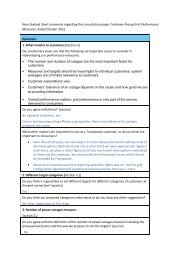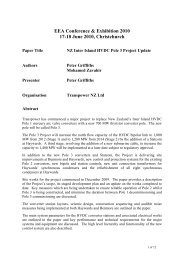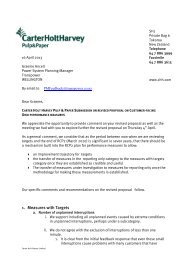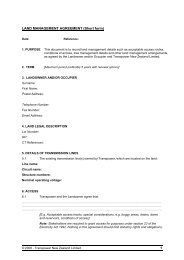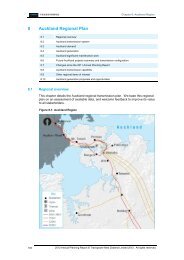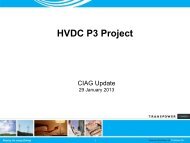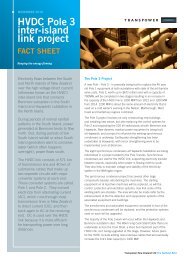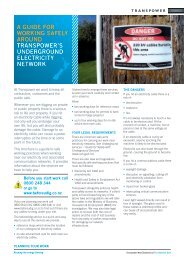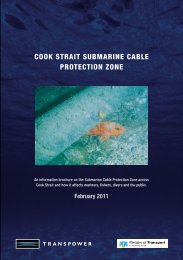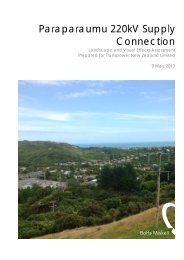Procurement process - Transpower
Procurement process - Transpower
Procurement process - Transpower
- No tags were found...
Create successful ePaper yourself
Turn your PDF publications into a flip-book with our unique Google optimized e-Paper software.
The SSC Group Approach 2011The Sourcing, Supply & Contracts ApproachVersion 2.01
The SSC Group Approach 2011Table of ContentsIntroduction .................................................................................................................. 31.1 The Sourcing, Supply and Contracts Group Vision .................................................... 31.2 The Sourcing Supply and Contracts Group Objectives ............................................... 31.3 The Sourcing Supply and Contracts Group Strategy requires: .................................... 31.4 Alignment to Corporate Objectives ........................................................................ 41.5 <strong>Procurement</strong> Strategies Aligned to Asset Strategies (PAS-55) .................................... 51.6 Supplier Alignment to <strong>Transpower</strong> organisational structure ...................................... 61.7 The <strong>Procurement</strong> Process ..................................................................................... 71.8 How SSC assists during the <strong>Procurement</strong> Process ..................................................... 81.9 The SSC Team ...................................................................................................... 91.10 Cost Estimation Management (US Cost) – right price, correct cost ........................... 101.11 Category Management – initiate & plan, who we buy from & why ........................... 111.12 Contract and Tender Management - builds the foundations of successful contractualrelationships ...................................................................................................... 121.13 Supply Management -what we need and when we need it ...................................... 131.14 Supplier Relationship Management – continuous improvement of supplier performancethrough healthy relationships .............................................................................. 141.15 Definitions of “Key <strong>Procurement</strong>” terminology ...................................................... 151.16 Total Cost of Ownership (“Whole of Life” Cost) ...................................................... 151.17 Value Proposition ............................................................................................... 151.18 Principle of Least Cost ......................................................................................... 161.19 <strong>Procurement</strong> Plans ............................................................................................. 161.20 <strong>Procurement</strong> Strategies ...................................................................................... 161.21 Delegated Authority and Delegated Financial Authority .......................................... 172
The SSC Group Approach 2011IntroductionThis document describes the approach to and functions of procurement within <strong>Transpower</strong>. TheSourcing Supply and Contracts (SSC) team exist to support <strong>Transpower</strong> in procurement. Although theteam resides in Grid Projects it is responsible for assisting stakeholders company-wide in theirprocurement.1.1 The Sourcing, Supply and Contracts Group VisionTo be the trusted advisor for all procurement within <strong>Transpower</strong>.1.2 The Sourcing Supply and Contracts Group ObjectivesThe objectives of the centre-led 1 SSC function are to:1. Develop and operate a robust, simple, and standardised purchasing <strong>process</strong> for all of<strong>Transpower</strong>, which meets stakeholder requirements, and is consistent with relevantgovernment and commercial “better procurement” practices.2. Operate a supply chain for <strong>Transpower</strong> that effectively:a. Manages supply risk and maximises supply opportunity.b. Identifies and manages procurement risk in conjunction with business owners.<strong>Procurement</strong> risk examples include forward exchange cover and other hedging risks;delivery and manufacturing risks, and quality of manufactured goods. Risk managementassociated with logistics includes shipping, local transport, warehousing, anddistribution and insurance to support corporate and divisional requirements.3. Manage major supplier relationships in conjunction with and to support the business owner ofthat relationship.4. Deliver least cost of supply by aggregating and leveraging demand, and using otherconsolidated approaches to strengthen <strong>Transpower</strong>’s purchasing potential.1.3 The Sourcing Supply and Contracts Group Strategy requires:A focus on business strategyEarly input into Cost Estimation for ProjectsA clear understanding of our supply chainAdoption of objective sourcing strategiesEnsure the procurement <strong>process</strong>es are fully integrated into wider business <strong>process</strong>esDevelopment of Contract forms and assistance with negotiation strategies1center-led procurement is where strategic decisions are coordinated centrally while transactional activitiesare decentralised across the organisation3
The SSC Group Approach 2011High quality strategic relationship managementTo be recognised as a preferred customerTo be customer-orientated. (internal stakeholders)The role of (SSC) is to assist stakeholders across <strong>Transpower</strong> in the sourcing, selecting, securing andmanaging of suppliers for the delivery of goods and services, on which <strong>Transpower</strong> relies in meeting itscurrent and future business needs. SSC seeks to provide a range of support to the business from “tell uswhat you want, we’ll buy it” and guidance on <strong>process</strong> to helping stakeholders understand how they cancontribute to purchasing decisions that add value to the business.( eg: <strong>Procurement</strong> strategies/ plans,using economies of scale for better sourcing, supplier leverage and added value through strategicrelationship management.This is achieved through:1. Capable and well trained professional procurement staff working closely with all stakeholderswithin <strong>Transpower</strong>2. Actively managing supply markets both strategically and tactically to ensure optimum value formoney outcomes3. Management of key supplier relationships to ensure agreed performance is achieved and addedvalue opportunities are explored4. Ensuring efficient use of working capital commencing with accurate Cost estimation through tothe minimisation of project supply delivery risk using smart logistics, warehousing andinventory.In addition to the above, SSC also provides guidance on Policy. (eg: <strong>Procurement</strong>)1.4 Alignment to Corporate Objectives4
The SSC Group Approach 20111.5 <strong>Procurement</strong> Strategies Aligned to Asset Strategies (PAS-55)Whole of life asset management involves managing risk exposure and performance attributes, andconsiders the asset’s complete economic life as the result of sound sustainable procurement practice.<strong>Transpower</strong> has established and implemented an Asset Management Policy and supporting assetmanagement strategy, objectives, plans and on-going document maintenance. <strong>Transpower</strong>’s goals andstrategic priorities are directly reflected in <strong>Transpower</strong>’s Asset Strategies, which have a cascading effectthrough to operational performance matters, as illustrated in the image overleaf.Working with <strong>Transpower</strong> stakeholders, SSC develops <strong>Procurement</strong> Strategies, based upon AssetStrategies, and help to provide for systematic and coordinated activities and practices. This enablesoptimal and sustainable management of <strong>Transpower</strong> assets and asset systems, their associatedperformance, risk, and expenditures over the whole life cycle, thus supporting the achievement of<strong>Transpower</strong>’s business objectives and PAS 55 principles (PAS 55-2:2008).<strong>Procurement</strong> Strategies are completed for each category in association with the Asset ManagementStrategies. These are commonly completed by the Category Manager for the Asset Category within SSC.5
The SSC Group Approach 20111.6 Supplier Alignment to <strong>Transpower</strong> organisational structureThere are always multiple engagements between supplier’s staff and <strong>Transpower</strong> staff through the lifecycle of aSupplier engagement. By focusing on alignment and overall management of the key supplier relationships,<strong>Transpower</strong> is expecting a more efficient and beneficial relationship.Benefits of fulfilling key supplier alignment include:1. Ensure consistent responses to same suppliers from different parts of the business2. Avoid supplier “working the cracks”3. Allows better Supplier performance management4. Ability to leverage overall spend and overall relationship5. Provides a highly leveraged return on investment whilst mitigating risk, for the Business6. Ensure Suppliers understand <strong>Transpower</strong>’s business objectives and cultureEXE = Executive6
The SSC Group Approach 20111.7 The <strong>Procurement</strong> Process<strong>Transpower</strong>’s <strong>Procurement</strong> Policy CP.B.CS.008 outlines <strong>Transpower</strong>’s approach to procurement. The options forprocurement <strong>process</strong>es are detailed within the Policy and illustrated below.7
The SSC Group Approach 20111.8 How SSC assists during the <strong>Procurement</strong> ProcessFrom an end to end delivery to disposal life cycle of capital projects the diagram below highlights theinteraction areas between SSC and the internal clients (stakeholders). This assistance is the normallifecycle <strong>process</strong> at a high level.SRM = Supplier Relationship Management for our key suppliers. SRMs deliver the overall singleconsolidated view from a relationship and engagement perspective.8
The SSC Group Approach 20111.9 The SSC TeamThe diagram below illustrates key functions of the SSC team.Category Management: Initiate and Plan who we buy from and whySupply Team: What we need, when we need itManage inventory:•On time•To budget•Fit for purpose•Logistics and warehousing•Develop strategy•Quality•Risk•Market analysis•Supplier analysisSupplier Relationship Management: Continuousimprovement of supplier performance throughhealthy relationshipsContract and Tender Management : Builds theFoundation of successful contractual relationshipsVISION: To be the trusted advisor for all procurementWithin <strong>Transpower</strong>Sourcing, Supply and Contracts GroupPURPOSE: To source, select, secure and managesuppliers in the delivery of goods and services•Governance andengagement•Relationships•Stakeholdermanagement•PlanningCost Estimation: Right Price, Correct Cost•Risk•No ambiguity•Contractdevelopment andmanagement•Life CycleManagement•Cost estimation forGUPs• Maintain pricebook•MaintenanceServices – Auditprice quotationsand review• Input to businesscases9
The SSC Group Approach 20111.10 Cost Estimation Management (US Cost) – right price, correct costFunction: The Cost Estimation Management team exists to manage and be accountable fordeveloping accurate cost estimates for asset works programmes (Using a tool called US-Cost).10
The SSC Group Approach 20111.11 Category Management – initiate & plan, who we buy from & whyFunction: The Category Management team are champions of the procurement category aiming forexcellence in end to end procurement performance.The Categories are:Power TransformersPrimary AssetsProtection and CommunicationsLines and CablesInformation Services and Technology11
The SSC Group Approach 20111.12 Contract and Tender Management - builds the foundations of successful contractualrelationshipsFunction: The Contract Management team is responsible for providing commercial assistance for allaspects pertaining to terms and conditions from proposal, negotiations and contract execution.RFP = Request for Proposal, RFT = Request for Tender12
The SSC Group Approach 20111.13 Supply Management -what we need and when we need itFunction: The Supply Management team is responsible for providing the fulfilment of inventory viathe Warehouse operations team to all key Stakeholders within <strong>Transpower</strong> and for forecasting,analysing and purchasing current and future inventory requirement to develop necessary inventorylevels for Just in time delivery within Least “whole of life” cost.13
The SSC Group Approach 20111.14 Supplier Relationship Management – continuous improvement of supplierperformance through healthy relationshipsFunction: The Supplier Relationship Management Team exists to manage and be accountable forsupplier relationship; governance and engagement.14
The SSC Group Approach 20111.15 Definitions of “Key <strong>Procurement</strong>” terminologyBelow is a set of key procurement terms and their definitions, many of which are contained within<strong>Transpower</strong>’s <strong>Procurement</strong> Policy CP.B.CS.008.1.16 Total Cost of Ownership (“Whole of Life” Cost)Description: The total cost of ownership is the sum of direct and indirect costs associated with anasset or acquisition over its entire life cycle.When assessing a procurement proposal, personnel need to be aware of the “whole of life” cost of thegoods or services they are procuring.This includes the total direct capital investment plus indirect costs of manufacturing inspections, designreviews, final acceptance testing, installation, training, repairs, downtime, technical support, andupgrading, maintenance, servicing and support, and cost of disposal at end of life and the recovery ofproceeds from disposal. In other words, it’s the cradle to grave life cycle costs.Often, the acquisition cost of a product is only a small proportion of the total cost of ownership. Usually,most of the total cost lies in operating and maintaining the product over its life.This makes it important to base a procurement decision not only on the acquisition price but also on thecosts of using and disposing of the product or service.When assessing the “whole of life” cost, personnel should differentiate between one-off costs andrecurring costs, and capture both cost types in the purchase decision-making <strong>process</strong>.Whilst one-off costs are “sunk” once the initial acquisition is made, and are generally accurate andpredictable, operational and maintenance costs recur across a life cycle, and can vary significantly,sometimes increasing with time if the product is subject to wear and tear.1.17 Value PropositionDescription: Value Proposition means using resources effectively, economically, and without waste,with due regard for the total costs and benefits of an arrangement, and its contribution to theoutcomes the entity is trying to achieve.The principle of the Value Proposition when procuring goods or services does not necessarily meanselecting the lowest price but rather the best possible outcome for the total cost of ownership (orwhole-of-life cost).The Value Proposition is achieved by selecting the most appropriate procurement method for the riskand value of the procurement, and not necessarily by using a competitive tender.R= Responsible A = Accountable C = Consulted I = Informed15
The SSC Group Approach 20111.18 Principle of Least CostDescription: Provides explanation of determining the lowest whole of life cost for a ‘good’ or ‘service’.Definition: “Least cost means demonstrating the most appropriate technical solution to safely meet specifiedperformance criteria, delivered within the time required at the lowest whole of life cost for a ‘good’ or ‘service’. Itprovides the right technical solution at the right time at the lowest overall cost to customers”.Practical Application of Least-Cost:A Least Cost purchase does not necessarily mean selecting the lowest price, but rather achieving thebest possible outcome for the total cost of ownership over the life of the item procured.Least Cost purchasing is achieved by selecting the most appropriate purchase method for the risk andvalue of the purchase, which may not necessarily mean using a competitive tender.Least Cost purchasing encompasses a best-value-for-money principle and aligns with the <strong>Transpower</strong><strong>Procurement</strong> Policy CP.B.CS.008.1.19 <strong>Procurement</strong> PlansDescription: <strong>Procurement</strong> Plans are required so that we understand what and how we are going topurchase third party goods and/or services. They are usually completed by Category Manager and/ orthe Contracts Manager on behalf of the project managers.<strong>Procurement</strong> Plans are generally required for external purchases over $500,000. Any exceptions to thisrule may only be authorised by the CEO and it is important to keep a record of this authorisation foraudit purposes.SSC considers it prudent for <strong>Procurement</strong> Plans to be completed for purchases over $250,000particularly if they are complex purchases or involve risks that are unique to <strong>Transpower</strong>. Guidance canbe sought from the relevant SSC team member.1.20 <strong>Procurement</strong> StrategiesDescription: <strong>Procurement</strong> Strategies are required to align with the overall asset / category strategy.These will be high level view of markets, Market capability and supplier capability.. They are usuallycompleted by Category Manager in association with the Asset Owners.16
The SSC Group Approach 20111.21 Delegated Authority and Delegated Financial AuthorityDescription: DA and DFA are described in the Delegated Authority Policy CP.B.CS.004. The purpose ofthe Delegated Authority (DA) Policy is to establish the framework for how <strong>Transpower</strong> empowersemployees by granting rights to conduct the day to day affairs of <strong>Transpower</strong>.17




